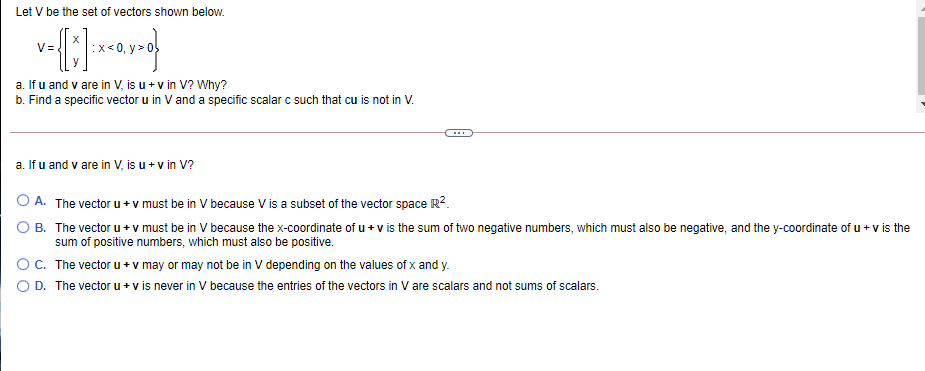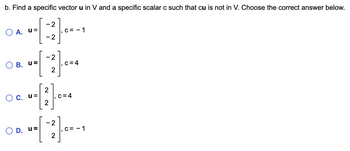Let V be the set of vectors shown below. V= a. If u and v are in V, is u + v in V? Why? b. Find a specific vector u in V and a specific scalar c such that cu is not in V. a. If u and v are in V, is u + v in V? O A. The vector u + v must be in V because V is a subset of the vector space R?. O B. The vector u + v must be in V because the x-coordinate of u + v is the sum of two negative numbers, which must also be negative, and the y-coordinate of u + v is the sum of positive numbers, which must also be positive. OC. The vector u + v may or may not be in V depending on the values of x and y. O D. The vector u + v is never in V because the entries of the vectors in V are scalars and not sums of scalars.
Let V be the set of vectors shown below. V= a. If u and v are in V, is u + v in V? Why? b. Find a specific vector u in V and a specific scalar c such that cu is not in V. a. If u and v are in V, is u + v in V? O A. The vector u + v must be in V because V is a subset of the vector space R?. O B. The vector u + v must be in V because the x-coordinate of u + v is the sum of two negative numbers, which must also be negative, and the y-coordinate of u + v is the sum of positive numbers, which must also be positive. OC. The vector u + v may or may not be in V depending on the values of x and y. O D. The vector u + v is never in V because the entries of the vectors in V are scalars and not sums of scalars.
Linear Algebra: A Modern Introduction
4th Edition
ISBN:9781285463247
Author:David Poole
Publisher:David Poole
Chapter2: Systems Of Linear Equations
Section2.3: Spanning Sets And Linear Independence
Problem 21EQ
Related questions
Question
7

Transcribed Image Text:Let V be the set of vectors shown below.
V=
a. If u and v are in V, is u + v in V? Why?
b. Find a specific vector u in V and a specific scalar c such that cu is not in V.
a. If u and v are in V, is u+ v in V?
A. The vector u+ v must be in V because V is a subset of the vector space R?.
B. The vector u + v must be in V because the x-coordinate of u + v is the sum of two negative numbers, which must also be negative, and the y-coordinate of u + v is the
sum of positive numbers, which must also be positive.
OC. The vector u + v may or may not be in V depending on the values of x and y.
D. The vector u + v is never in V because the entries of the vectors in V are scalars and not sums of scalars.
Expert Solution
This question has been solved!
Explore an expertly crafted, step-by-step solution for a thorough understanding of key concepts.
This is a popular solution!
Trending now
This is a popular solution!
Step by step
Solved in 2 steps with 1 images

Follow-up Questions
Read through expert solutions to related follow-up questions below.
Follow-up Question

Transcribed Image Text:b. Find a specific vector u in V and a specific scalar c such that cu is not in V. Choose the correct answer below.
O
O
u=
B. u=
6
u=
u=
- 2
- 2
- 2
2
2
2
- 2
2
C = -1
c=4
c=4
C = -1
Solution
Recommended textbooks for you

Linear Algebra: A Modern Introduction
Algebra
ISBN:
9781285463247
Author:
David Poole
Publisher:
Cengage Learning

Elementary Linear Algebra (MindTap Course List)
Algebra
ISBN:
9781305658004
Author:
Ron Larson
Publisher:
Cengage Learning

Linear Algebra: A Modern Introduction
Algebra
ISBN:
9781285463247
Author:
David Poole
Publisher:
Cengage Learning

Elementary Linear Algebra (MindTap Course List)
Algebra
ISBN:
9781305658004
Author:
Ron Larson
Publisher:
Cengage Learning